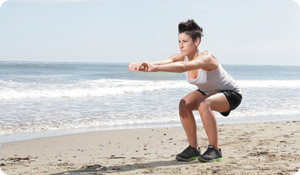
Looking for an easy exercise that you can do in a few minutes and will yield results almost as quickly? Try super squats, suggests Carolyn Dean, MD, ND, a doctor, exercise and nutrition expert, and author of Dr. Dean's Future Health! series and The Complete Natural Guide to Women’s Health.
What’s so superlative about this activity? "A super squat is a special type of squatting exercise. It features the legs and also involves movement of the arms along with rhythmic breathing. Once you get into a groove with this exercise it can be very exhilarating," she says.
Super Squat Directions
Dean shares the following instructions for how to do super squats properly:
- Stand straight, with your feet shoulder-width apart.
- Inhale deeply, clench your hands into fists (but keep your body relaxed), and bring your arms up to shoulder height, so that they’re parallel to the floor.
- Exhale and swing your arms down and out in front of you, opening your fists. Continue swinging you arms down and as far back behind you as they will go.
- At the same time, squat down on your feet, raising your heels.
- Once down, immediately begin to inhale, swinging your arms forward and pushing off your toes.
- As you rise, the arms come back up to your chest clenched as fists.
Things to Consider
"Notice how the movements rebound off each other. Your arms and legs come down as you move onto your toes," Dean says. "As you dip down, you collapse your diaphragm [the muscle and tendon separating the chest from the abdomen] naturally, creating an exhalation. As you move back up, your diaphragm can expand while you inhale deeply. As you come back, you can make a point of grazing the ground with your fingertips (a good way to make sure you squat low enough)."
Timing Matters
Dean recommends beginning with 12 super squats (count them as you go to help stay focused). If that’s too easy, do more. If that’s too hard, do less. And if you’re overweight, squatting is going to be more of a workout, which will make your body burn that extra weight and turn it into muscle, according to Dean.
Consider Speed
She cautions that you should perform the exercise very slowly, since it can be intense: "If you have any knee problems whatsoever, go even slower. If the 'hinges' of your knees are rusty, you have to very slowly work that rust out! You don’t even have to go onto your toes with this exercise. Keeping your feet flat may not create a super squat but it will still give you a good workout," she adds.
Moving slowly will give you more of a workout more geared towards strength training than cardio; moving faster will give you more of a cardio workout as you start to build momentum. Try alternating between the two speeds every 12-24 squats. (If you start with only a few squats, just build up as needed.)
The Many Benefits of Super Squats
Dean says that doing super squats regularly can:
- Mobilize and strengthen your hips and help avoid fractures.
- Give your knees and ankles a workout and help rehabilitate these areas if they’ve been injured or weakened.
- Burn fat off your thighs and calves.
- Build muscle and strengthen your back.
- Alleviate lower back pain.
- Build lung power, making you breath deeply, refreshing your entire body and mind.
- Firm and tone your buttocks.
- Help prevent osteoporosis by strengthening your bones.
- Strengthen the ligaments and tendons of your lower body.
- Improve the flexibility of all the joints from your hips to your toes.
- Build explosive power in your lower body, helping you walk, run or climb stairs with greater endurance and speed.
- Avoid any undue strain and the potential problems that go along with weight lifting equipment since you are using your own bodyweight (unless you are very overweight).
- Improve digestion and get your colon moving.
- Assist libido.
- Calm and energize your entire body.
- Improve balance.
Carolyn Dean, MD, ND, reviewed this article.
Sources
Dean, Carolyn, MD ND. Member of the medical advisory board of The Nutritional Magnesium Association. Email interview, Dec. 1, 2014.





